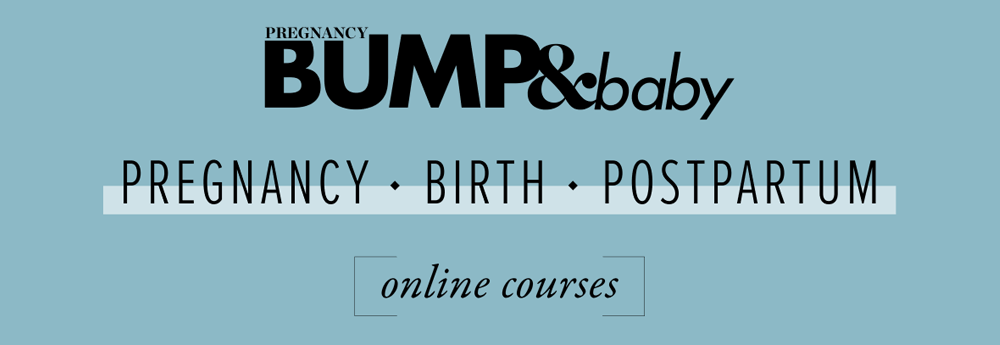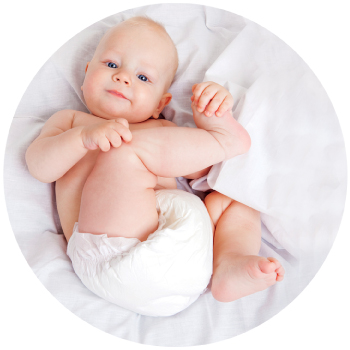
Think of your stretch marks as a pregnancy souvenir! Loathe them, embrace them, or be lucky enough to escape them altogether: Stretch marks are just one of the rites of passage many women will face during their pregnancy, says Tiffany Brown
It’s estimated as many as 90% of women experience stretch marks, which are narrow streak-like lines that develop on the skin. Medically referred to as “striae gravidarum”, they most often affect the abdomen as your skin stretches to accommodate your growing baby. In some cases the thighs, buttocks, hips and breasts can also be affected as your pregnancy progresses. Stretch marks tend to appear in places where large amounts of fat are stored, so you are more likely to experience them if you are overweight when you get pregnant, or if you gain more weight than is recommended during your pregnancy. Yet another good reason to get off the couch and try to resist those French fries!
Pregnancy stretch marks are caused by the physical stretch of the skin, and the lack of sufficient time the skin has to adjust to the body expanding beneath it. This causes the skin to tear, with the resulting scar forming a stretch mark.
There is a second factor at play in the formation of stretch marks – though still under debate among experts – concerning those good old pregnancy hormones you hear so much about. It is suggested the hormones may relax the bonds between collagen fibres by holding more water in the skin, making it easier for the skin to tear.
There are three stages to the formation of stretch marks, beginning with streaks that appear pink in colour and are often itchy. Skin around the marks may appear slightly flattened. Secondly, the marks enlarge and become a reddish or purplish colour, and lastly – after pregnancy – they will fade and become pale white or silver. Generally the marks will become considerably less noticeable by six to 12 months following your baby’s arrival.
Why some women suffer more than others is somewhat of a mystery, although it’s generally agreed genetics play a role. If your mother or sisters had pregnancy stretch marks, then you are also likely to experience them. As mentioned, excess weight gain can be a contributing factor, so you’re more likely to develop stretch marks if you’re carrying multiple babies, a single very large baby, or if you have excess amniotic fluid during your pregnancy.The theory behind topical creams and ointments marketed to prevent pregnancy stretch marks is that by hydrating and conditioning the skin, thereby improving its elasticity and suppleness, you can help your skin to “keep pace” with your growing belly so it simply stretches with it rather than developing tears. Topically applied products can also help reduce the itchiness that is often associated with stretching skin. Proponents of natural prevention strategies suggest a number of ways to prevent stretch marks, such as the twice-daily application of liquid coconut oil to the skin, massaging it in to the area to aid absorption and improve skin moisturisation. Castor oil is also recommended as a humectant to help the skin retain moisture. Daily or several times a week, apply a thick layer to the area, wrap tightly with plastic wrap and apply heat with a hot water bottle or similar for a minimum of 20 minutes. Other natural options include improving hydration levels by increasing your intake of water to two litres a day, and ensuring you eat a nutritious diet rich in vitamins C, E, zinc and silica. Vitamin E is also very important for improving skin elasticity. Foods rich in vitamin E include almonds, olives, sunflower seeds, spinach, and avocados. Topical vitamin E products or oral supplements may also help. If you’re unable to prevent stretch marks from occurring, and they cause considerable distress, the marvels of modern medicine may have a solution for you. Visit a dermatologist or skin specialist who can discuss various treatment options to minimise their appearance. Topical medications such as Retin-A or glycolic acid may help, but be sure to wait until you are well and truly done with pregnancy and breastfeeding as these products are unsafe to use in either situation. Otherwise, laser treatments may help to alter your pigmentation so the marks are a better colour match with the rest of your skin, blending their appearance away. While you’re certainly not alone if you’d prefer those pregnancy stretch marks to fade into obscurity along with your memories of morning sickness and other such pregnancy delights, it’s also true that some women consider their stretch marks to be a wonderfully affirming souvenir of pregnancy. Actress and mother-of-two Alyssa Milano recently said, “I love my stretch marks. Some people might see them as imperfections, but when you have a baby, those are your beauty marks.” Fellow actress Jessica Alba feels the same, saying, “Even though some might consider them a flaw, I’ve learned to love my stretch marks. Pregnancy was the most incredible experience I’ve ever had. So I’ll take the stretch marks. I’ll take the cellulite I can never get rid of.” And it’s not just celebrity mums flying the flag for finding joy in their altered post-baby bodies. Online forums reveal countless women embracing their new forms, and – in true sisterhood solidarity – encouraging others to do the same. One anonymous blogger authored these words: “A mark for every breath you took, every blink, every sleepy yawn. One for every time you sucked your thumb, waved hello, closed your eyes and slept in the most perfect darkness. It isn’t very pretty anymore. Some may even think it’s ugly. That’s OK. It was your home. It’s where I first grew to love you, where I lay my hand as I dreamed about who you were and who you would be. It held you until my arms could, and for that, I will always find something beautiful in it.” However you are inclined to view your personal marks of pregnancy, take heart that they represent the phenomenal and life-changing journey through pregnancy.
BUMP&baby
BUMP & baby is New Zealand’s only magazine for pregnancy and early babyhood. Our team of mums and mums-to-be understand what it’s like to be pregnant in this connected age, and that’s why BUMP & Baby online is geared toward what pregnant women and new mums really want to know.
Other articles of interest
A wonderful first-time birth
When people ask me about my birth story, I always tell them not to let other people’s horror stories put them off
Nappies 101
One of the less-savoury but necessary parts of new parenting is learning how to become a nappy-changing pro







